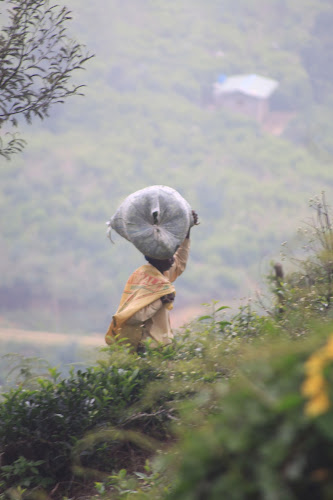The conversation in my head was consistently nagging me. To climb or not to climb? If only it was as poetic as a Shakespearian line, instead it weighed heavily. Prior to my accident it was obvious, of course I'd be climbing to the top of Adams Peak, along with however many others who make the pilgrimage to the top.
A snapped plantaris tendon can put a lot of doubt in your mind...
Adams Peak, locally known as Sri Pada (holy footprint), is visited by thousands of pilgrims each year. The Buddhists believe it was visited by Buddha, Muslims and Christians believe it was Adam who visited and Hindus say that it was the home of Shiva.
It's a steep upward climb which starts off as a slope and gradually turns into a climb of over 5200 stairs.
The conversation goes a bit like, " don't be so stupid, what if you re- injure your leg"
"Come on do it!"
"I've got nothing to prove"
"You'll be disappointed if you don't!"
Damn internal dialog!
We approached the mountain by train to Hatton then bus to Dalhousie. When the mountain came into view outside the bus window, I knew I would do it. It was my pilgrimage, my challenge, I could always stop if I needed to.
Leaving at 2am in the morning, we made sure we had extra clothes for the top, It's an elevation of 2240 m and can get cold. The weather was fine and the path was illuminated all the way. Casting our eyes upward we could see the lights snaking their way ever upwards. Small tea houses were scattered along the way for rest and warmth. People of all ages make the climb, many were barefooted.
As we approach the top, the stairs get steeper and there's no doubt that it's tiring. The cold air wraps itself around us, the early dawn light is awakening. We remove our shoes as we reach the monastery. The final stairs are highly congested. Our shoes join the sea of shoes left by others as everyone tries to push their way through on the surrounding forecourt to get a view. People jostle and push aiming to see the sunrise. The clear morning promises a great show.
As the sun begins to peak, the surrounding mutters turn to 'oohs and ahhs'. Could I call it peaceful and serene? No, but definitely interesting. I'm so busy taking it all in, the masses of people, when a calm descends over me and I am taken by the beauty of the fluttering flags. As they toss in the wind the sun reveals itself from behind them. It truly is beautiful. Soon after the sun has risen, the crowd begins to disperse. A few minutes later the bells begin to toll and drumming and chanting from the monks fills the air.
Small children who have made the journey, many on the shoulders of their dads or mums, many who did it on their own, stand sleepily amongst the crowd. Teenagers and the elderly, families who have helped grandma 'one last time', all have come, making their pilgrimage.
Making our way around to the other side of the monastery, we are rewarded again, the pyramid shaped shadow reveals itself in the clouds, the bells toll, the drumming continues.
People crowd in meditation and prayer. Blessings are made and returned.
The journey down, was, of course tiring, but who was I to complain. My leg was feeling fine, I ached, sure, but looking around and seeing the dedication of these people is nothing short of inspiring. The elderly women, in their bare feet who have been supported by their families to make their last journey; they are my inspiration!
I meet a woman of 65, we begin to talk. her heart is overflowing with happiness, this is her sixth time to make the pilgrimage. She, like me is tired. She has bare feet and wears white. The bottom of her skirt is wet and muddy. She is a retired teacher, we chat about various things. She has visited India Twice to help 'those in need' she is so happy to have walked today and give offerings to be able to continue to help others.
When we are so close to the finish, Brenda arrives. She is from our guesthouse,The Green House. At 85 she has made the pilgrimage 83 times and literally bounces around. She jogs up the steps to the guesthouse to make me a cup of tea...














































